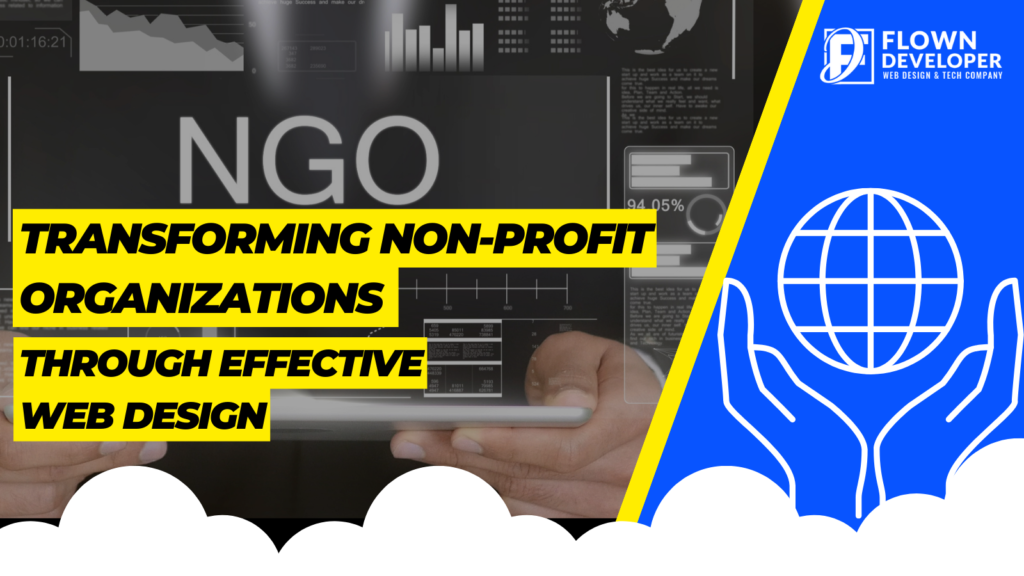Transforming Non-Profit Organizations through Effective Web Design
I. Introduction to Web Design for Non-Profit Organizations
Non-profit organizations need an online presence to effectively reach their target audiences, raise awareness about their causes, and achieve their objectives in today’s digital age.
Visually appealing and user-friendly web design drives visitors to take action on your website by engaging them.
This article explores the importance of web design for non-profit organizations and highlights key elements that contribute to an effective website design.
A. Importance of Web Design for Non-Profits
It’s not just about making a website visually appealing; it’s about establishing an online platform that effectively represents the mission and values of a non-profit organization.
A well-designed website can establish credibility, build trust, and encourage visitors to explore and engage with the organization.
It serves as a powerful tool for storytelling and connecting with potential donors, volunteers, and supporters.
B. Benefits of a Well-Designed Website
A well-designed website offers numerous benefits for non-profit organizations:
It enhances the user experience by providing intuitive navigation, ensuring easy access to information, and optimizing the site for mobile devices.
It helps attract and retain visitors by creating an engaging visual design that captures attention and conveys the organization’s message effectively.
It drives conversions by strategically placing compelling call-to-action buttons throughout the website.
C. Understanding the Target Audience
Before diving into the web design process, understanding the non-profit organization’s target audience is crucial.
Identifying their preferences, interests, and online behavior will guide the design decisions and content strategy.
Conducting user research and creating user personas can provide valuable insights into the target audience’s needs and expectations, allowing for a more tailored and practical web design approach.
II. Key Elements of Effective Web Design
To create a successful website for a non-profit, several key elements must be considered during the web design process.
Visitors are more likely to engage with your website and convert due to these elements.
Drive visitor engagement and conversions.
A. Clear and Intuitive Navigation
Straightforward and intuitive navigation is essential to help visitors quickly find the information they seek.
The website is easy to navigate and locate relevant content with well-organized menus, breadcrumbs, and search functionality.
Consistent placement of navigation elements across all pages ensures a seamless browsing experience.
B. Responsive Design for Mobile Devices
Mobile optimization is essential for non-profit websites with increasing smartphone and tablet users.
Responsive design ensures the website adapts to different screen sizes and resolutions, providing a consistent and user-friendly experience across all devices.
Mobile-friendly websites also rank higher in search engine results, improving visibility and reach.
C. Engaging Visual Design
The visual design captures visitors’ attention and effectively conveys the organization’s message.
High-quality images, videos, and graphics help create a visually appealing and engaging website.
Consistent branding elements, such as color, fonts, and logos, reinforce the organization’s identity and build recognition.
D. Compelling Call-to-Action Buttons
Strategically placed call-to-action (CTA) buttons throughout the website encourage visitors to donate, sign up for a newsletter, or volunteer.
CTAs should be visually distinct, use persuasive language, and create a sense of urgency to drive conversions.
A/B testing can be employed to optimize the effectiveness of CTAs and improve conversion rates.
III. User Experience Optimization
Delivering an exceptional user experience is crucial for non-profit websites.
By prioritizing user-centric design principles, organizations can create websites that are intuitive, accessible, and user-friendly.
A. Creating a User-Centric Design
A user-centric design approach involves understanding the target audience’s needs, goals, and behaviors and designing the website accordingly.
User research, usability testing, and feedback analysis can provide valuable insights to inform design decisions and optimize the user experience.
B. Enhancing Page Load Speed
Website speed is critical to user experience and search engine optimization (SEO). Slow-loading pages can lead to visitor frustration and increased bounce rates.
Optimizing images, minifying code, and leveraging caching techniques are some strategies to improve page load speed and ensure a smooth browsing experience.
C. Implementing User Feedback Mechanisms
Non-profit organizations can gather valuable feedback from website visitors to enhance their services and offerings.
Implementing user feedback mechanisms, such as surveys, feedback forms, and user testing, allows organizations to gain insights, identify areas for improvement, and make data-driven design decisions.
D. Incorporating Accessibility Features
Web accessibility is essential to ensure that the website can be accessed and used by individuals with disabilities.
Incorporating accessibility features, such as alternative text for images, keyboard navigation support, and proper color contrast, ensures inclusivity and compliance with accessibility standards.
IV. Content Strategy for Non-Profit Websites
Compelling and relevant content is the backbone of a successful non-profit website.
A well-defined content strategy ensures that the website effectively communicates the organization’s mission, engages visitors, and drives them to take action.
A. Telling the Non-Profit’s Story
Storytelling is an effective tool to convey the impact of a non-profit’s work.
Through compelling narratives, personal anecdotes, and success stories, organizations can effectively communicate their mission, values, and the difference they are making in the world.
B. Crafting Persuasive Calls-to-Action
Calls-to-action (CTAs) are essential for guiding visitors toward desired actions.
By using persuasive language and clearly articulating the benefits of action, non-profit organizations can increase conversions and drive visitor engagement.
CTAs should be prominently placed and visually distinct to capture attention.
C. Incorporating Relevant Visual Media
Images, videos, infographics, and testimonials can significantly enhance the impact of a message.
By incorporating visually appealing and relevant media throughout the website, non-profit organizations can effectively communicate their message, evoke emotions, and engage visitors.
D. Utilizing Search Engine Optimization (SEO) Techniques
Search engine optimization (SEO) is crucial for improving the visibility of non-profit websites in search engine results.
Organizations can increase organic traffic and reach a wider audience by conducting keyword research, optimizing meta tags, creating informative and well-structured content, and building quality backlinks.
V. Donor Engagement and Online Fundraising
Engaging donors and facilitating online fundraising is a primary goal for many non-profit organizations.
Web design can create effective strategies to attract donations and foster long-term donor relationships.
A. Designing Effective Donation Pages
Donation pages should be designed to make the donation process simple, secure, and transparent.
Clear and concise donation forms, multiple payment options, and trust signals, such as security badges and testimonials, inspire confidence and encourage donors to contribute.
B. Integrating Social Media Sharing Features
Social media integration allows non-profit organizations to amplify their reach and engage supporters.
By incorporating social sharing buttons on content pages, blog posts, and success stories, visitors can easily share the organization’s message with their social networks, helping to increase awareness and attract new donors.
C. Showcasing Impact and Success Stories
Demonstrating the impact of donations and showcasing success stories is essential for donor engagement.
Non-profit websites can feature stories, testimonials, and real-time progress updates to demonstrate the tangible difference their donors are making.
Visual representations, such as infographics or interactive data visualizations, can effectively communicate the organization’s impact.
D. Implementing Email Marketing Strategies
Using email marketing to keep long-term donors can be very effective.
Non-profit organizations can leverage web design to create visually appealing email templates, incorporate personalized content, and strategically place email signup forms throughout the website to build an engaged subscriber base.
VI. Volunteer Recruitment and Engagement
Volunteers are invaluable assets for non-profit organizations. Web design can support volunteer recruitment efforts and enhance their overall organizational engagement.
A. Creating Volunteer Opportunities Pages
Dedicated pages highlighting volunteer opportunities provide detailed information and inspire individuals to get involved. These pages clearly outline the roles and responsibilities, requirements, and the impact volunteers can make. Incorporating testimonials from current volunteers can also showcase the rewarding experiences of volunteering.
B. Highlighting the Organization’s Mission and Impact
Volunteers are motivated by the mission and impact of an organization. Web design can effectively highlight the organization’s mission statement, goals, and the positive change it strives to achieve. Visual elements, such as images or videos showcasing volunteer work, can inspire potential volunteers and create an emotional connection.
C. Incorporating Testimonials from Volunteers
Testimonials from current or past volunteers provide social proof and can significantly influence others’ volunteer decisions. By incorporating volunteer testimonials strategically throughout the website, non-profit organizations can build trust, demonstrate the volunteer experience, and attract more individuals to join their cause.
D. Streamlining Volunteer Application Processes
A seamless and user-friendly volunteer application process is crucial for encouraging individuals to take the first step towards volunteering. Web design can simplify the application process by creating intuitive and easy-to-navigate forms, providing clear instructions, and ensuring that essential information is collected efficiently.
VII. Security and Privacy Considerations
Non-profit organizations handle sensitive information, including donor details and user data. Keeping this information secure and private is essential to maintain trust and comply with data protection laws.
A. Implementing SSL Certificates for Secure Communication
In order to protect sensitive information, such as donation details or user credentials, Secure Socket Layer (SSL) certificates encrypt the communication between the website and its visitors.
Non-profit organizations should implement SSL certificates to provide a secure browsing experience and build trust with their users.
B. Protecting Donor and User Information
Implementing robust security measures to protect donor and user information is essential. Non-profit organizations should follow industry best practices, such as regularly updating software and plugins, conducting security audits, and using secure hosting services to safeguard sensitive data.
C. Complying with Data Privacy Regulations
Non-profit organizations should ensure compliance with these regulations by obtaining consent, providing transparent privacy policies, and implementing mechanisms to handle data subject requests.
D. Ensuring Regular Website Maintenance and Updates
Regular website maintenance and updates are necessary to keep the website secure and functioning optimally. Non-profit organizations should have processes to address security vulnerabilities promptly, apply software updates, and perform regular backups to mitigate the risk of data loss.
VIII. Integration of Online Tools and Platforms
Non-profit organizations can leverage various online tools and platforms to streamline operations, manage relationships, and enhance their online presence.
A. Content Management Systems (CMS)
In order to manage their website content efficiently, non-profit organizations can use content management systems, such as WordPress.
CMS platforms allow easy content updates, provide flexibility for customization, and offer a wide range of plugins and extensions to extend website functionality.
B. Customer Relationship Management (CRM) Software
CRM software helps non-profit organizations track and manage donor relationships, store donor information, and streamline communication.
Integrating a CRM system with the website allows for efficient donor management, personalized interactions, and targeted fundraising campaigns.
C. Email Marketing Platforms
Non-profit organizations can create and send email campaigns, automate workflows, and analyze the performance of their emails with email marketing platforms like Mailchimp and Constant Contact.
Integrating email marketing platforms with the website allows seamless data synchronization and targeted email communication based on user behavior and preferences.
D. Donation Processing Systems
Donation processing systems, such as PayPal or Stripe, facilitate secure online transactions and simplify the donation process.
Integrating these systems with the website ensures users a seamless and trustworthy donation experience, increasing the likelihood of successful contributions.
IX. Summary and Conclusion
Effective web design is a powerful tool for transforming non-profit organizations and driving their success in the digital landscape.
By focusing on key elements such as clear navigation, responsive design, engaging visuals, and compelling content, non-profits can create user-friendly websites that engage visitors, attract donors, and foster volunteer participation.
Incorporating online tools and platforms, prioritizing security and privacy, and drawing inspiration from successful case studies further enhance the effectiveness of non-profit web design.
With a well-designed website, non-profit organizations can amplify their impact, engage their audience, and create lasting change.









